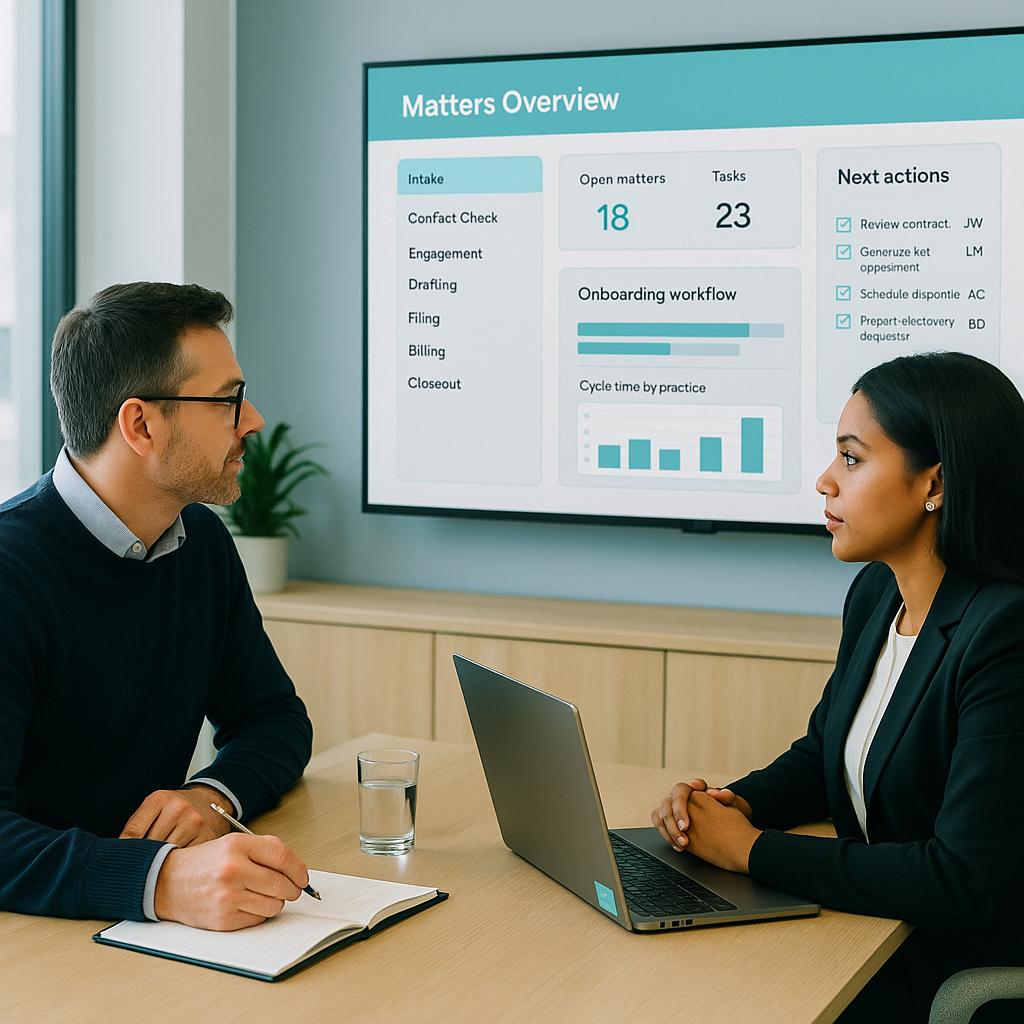The punchline: you are not buying “setup,” you are buying institutional memory
A good consultant has two kinds of experience. First, hundreds of hours inside law firms of different sizes, so they know the difference between how a boutique litigates and how a high-volume immigration shop lives and breathes. Second, deep product knowledge, so they can bend your software to your workflow instead of the other way around. That mix is what makes the difference between “we installed it” and “we run our firm on this now.”
What the consultant actually does, in plain English
1) Interviews the right people.
Not just the partners. The intake coordinator who knows where matters go to die. The paralegal who rescues deadlines. The billing lead who can spot time leakages with eyes closed. Give the consultant access to each role that touches a process. Without those voices, you get a glossy chart that no one follows.
2) Maps the workflows, step by step.
Every process gets broken into clear stages. Intake, conflict check, engagement, matter opening, drafting, review, filing, billing, closeout. Each stage gets owners, triggers, and outcomes. Then the consultant trims the fat. Duplicate forms vanish. Approvals get routed to one decision-maker instead of five.
3) Configures the software to mirror the map.
Custom fields for the data you actually track. Automations that create task lists when a matter status changes. Document templates that pull client names and clause choices without anyone retyping. Permissions that keep sensitive matters fenced off. Dashboards that show bottlenecks before they turn into apology emails.
4) Tests with real files.
A short pilot with sample matters catches weird edge cases. The system learns your firm’s quirks. Your team learns the clicks.
5) Trains people and launches clean.
Short trainings, role-based quick guides, and office hours during the first two weeks. Then a post‑launch tune-up to lock in what works.
DIY vs Consultant: Exhibit A
 DIY: “I think conflicts are fine.” Two months later you discover three associate-built spreadsheets and seventeen color codes no one can decode.
DIY: “I think conflicts are fine.” Two months later you discover three associate-built spreadsheets and seventeen color codes no one can decode.- Consultant: One conflict intake, one source of truth, one report that counsel actually reads.
- DIY: Task lists that live in five places, sometimes Slack, sometimes someone’s brain.
- Consultant: Status change triggers a single, reusable checklist with owners and deadlines.
- DIY: The template library is a haunted house.
- Consultant: Templates pull fields directly from the matter. Everyone drafts on the same rails.
- DIY: Adoption by enthusiasm. It fades by Friday.
- Consultant: Adoption by design. People use it because it saves time on day one.
Give your consultant what they need to work magic
Treat the engagement like litigation prep.

- People: Name a project sponsor. Pick one decision-maker per practice. Put intake, paralegals, billing, docketing, and IT in the room.
- Artifacts: Bring your current intake forms, engagement letters, checklists, and a few anonymized matters that show typical work.
- Rules: Spell out decision points. Who approves fee agreements. What triggers a trust request. When a matter is “trial ready.”
- Goals: Three measurable outcomes. For example, “reduce time from inquiry to engagement by 30 percent,” “eliminate duplicate data entry,” “generate first draft within two clicks of opening a matter.”
- Constraints: Compliance needs, naming conventions, retention rules, and who gets to see what.
A tiny ROI thought experiment
Save 12 minutes per person per day by ending duplicate entry and hunting for docs. With 20 people, that is 240 minutes saved daily, which equals 4 hours. Even with conservative rates, that is real money and real sanity. Now add fewer errors, faster intake, and better cash flow because billing is clean. The math starts smiling.
A quick mini‑case: from intake to first draft in eight clicks
 Intake form is completed on your website or by staff on the phone.
Intake form is completed on your website or by staff on the phone.- Conflict check runs and logs results inside the matter.
- Status flips to “Engaged.” The system creates a task list by practice type.
- Custom fields pull key facts.
- The engagement letter template generates with the correct fee terms.
- The client signs electronically.
- Tasks for discovery or initial filing populate with due dates and owners.
- The first pleading template drops a draft into your document system, already named correctly.
One path. No guessing. Everyone knows what comes next.
Common DIY pratfalls, or “how to create a future audit you will not enjoy”
- Unstable automations built by one enthusiastic associate who leaves.
- Shadow databases in Excel that quietly contradict the “system of record.”
- Security gaps because permissions were never standardized.
- Inconsistent templates that lead to client letters with yesterday’s logo.
- Reporting that lies since fields are optional or mislabeled.
- User rebellion when the tool makes work slower instead of faster.
A consultant’s boring superpower is preventing these.
How to know you hired a good one
- They start with questions, not software tours.
- They ask for sample matters and real documents.
- They can explain your workflow back to you more clearly than you described it.
- They propose small pilots and phased rollouts instead of a big-bang surprise.
- They leave behind governance: who owns templates, who approves changes, and how to request new automations.
The fun part: you get to practice more law
When software mirrors your firm, admin turns invisible. Intake becomes predictable. Tasks appear before you ask. Documents build themselves with fields you trust. Your dashboards show tomorrow’s problems today. Most importantly, your team stops playing “where is that thing” and starts playing “how do we win this case.”
Bottom line
 You could figure it out yourself. That is technically true of everything, including appendectomies and drywall. Or you could bring in a consultant like 2b1 Inc. who has already solved your exact problems ten different ways. Give them access to the people who live each process. Let them group the steps, trim the friction, and wire the software to do the heavy lifting. Your practice will feel lighter. Your billing will look better. Your nights will get quieter.
You could figure it out yourself. That is technically true of everything, including appendectomies and drywall. Or you could bring in a consultant like 2b1 Inc. who has already solved your exact problems ten different ways. Give them access to the people who live each process. Let them group the steps, trim the friction, and wire the software to do the heavy lifting. Your practice will feel lighter. Your billing will look better. Your nights will get quieter.
To find out more or about working with a consultants contact 2b1 Inc. at 415-284-2221 or fill out the firm below

